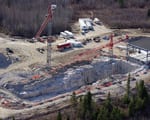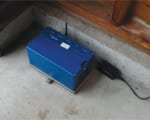The enormous capacity of SMU’s new supercomputer ranks it among the largest academic supercomputers in the nation.

SMU now has a powerful new tool for research – one of the fastest academic supercomputers in the nation – and a new facility to house it.
With a cluster of more than 1,000 Dell servers, the system’s capacity is on par with high-performance computing (HPC) power at much larger universities and at government-owned laboratories. The U.S. Department of Defense awarded the system to SMU in August 2013.
SMU’s Office of Information Technology added the system to the University’s existing – but much smaller – supercomputer. The system is housed in a new facility built at the corner of Mockingbird and Central Expressway. In a contest sponsored by Provost and Vice President for Academic Affairs Paul W. Ludden, faculty and students chose the name “ManeFrame” to honor the Mustang mascot.
The enormous capacity and speed of HPC expands scientific access to new knowledge around key questions about the universe, disease, human behavior, health, food, water, environment, climate, democracy, poverty, war and peace.
“World-changing discoveries rely on vast computing resources,” says President R. Gerald Turner. “ManeFrame quintuples the University’s supercomputing capacity. Our scientists and students will keep pace with the increasing demand for the ever-expanding computing power that is required to participate in global scientific collaborations. This accelerates our research capabilities exponentially.”
ManeFrame potential
With nearly 11,000 central processing unit cores, ManeFrame boasts 40 terabytes (one terabyte equals a trillion bytes) of memory and more than 1.5 petabytes of storage (a petabyte equals a quadrillion bytes), says Joe Gargiulo, SMU’s chief information officer, who led the installation team.
The sciences and engineering primarily use supercomputers, but that is expanding to include the humanities and the arts. So far, SMU’s heavy users are researchers in physics, math, biology, chemistry and economics.
“This technologically advanced machine will have an impact on shaping our world,” says Thomas M. Hagstrom, chair of the Department of Mathematics in Dedman College and director of SMU’s Center for Scientific Computing. “This makes research that solves problems on a large scale much more accessible. ManeFrame’s theoretical peak would be on the order of 120 Teraflops, which is 120 trillion mathematical operations a second.”
Supercomputers can use sophisticated software and step-by-step procedures for calculations, called algorithms, to solve complex problems that can’t be managed in a researcher’s lab, Hagstrom explains.
“We can’t put the Earth’s climate system or study the evolution of the universe in a physical lab,” he says. “You can only study these and other systems in a comprehensive way using high-performance computing.”
Making SMU competitive
Supercomputing gave University physicists a role in the Higgs Boson research at the Large Hadron Collider in Geneva, Switzerland. Joining the collaboration with thousands of scientists around the world, SMU’s team was led by Physics Professor Ryszard Stroynowski. SMU’s physicists tapped the existing HPC on campus to quickly analyze massive amounts of data and deliver results to their international colleagues.
SMU’s team will use ManeFrame to keep pace with an even larger flood of data expected from the Large Hadron Collider.
“ManeFrame makes SMU – which is small by comparison with many of its peer institutions at CERN – nimble and competitive, and that lets us be visible in a big experiment like CERN,” says Stephen Sekula, assistant professor of physics. “So we have to have ideas, motivation and creativity – but having a technical resource like ManeFrame lets us act on those things.”
SMU physicist Pavel Nadolsky has conducted “big data” analyses of subatomic particles on the supercomputer as part of an international physics collaboration. Big data refers to probability distributions that depend on many variables. As users ranging from retailers to the health industry collect multitudes of transactional data every day, requirements for big data analysis are rapidly emerging.
“To keep up in our field, we need resources like ManeFrame,” says Nadolsky, associate professor of physics.
“The world is moving into big-data analysis, whether it’s Google, Facebook or the National Security Administration,” Nadolsky says. “We learn a lot about the world by studying multidimensional distributions: It tells about the origins of the universe; it can win elections by using data mining to analyze voting probabilities over time in specific geographical areas and targeting campaign efforts accordingly; and it can predict what people are doing. To make students competitive they must be trained to use these tools efficiently and ethically.”
ManeFrame will have a high-profile role in the U.S. Department of Energy experiment called NOvA, which studies neutrinos, a little-understood and elusive fundamental particle that may help explain why matter, and not just light, exists in the universe today. SMU will contribute four million processing hours each year to the experiment, says Thomas E. Coan, associate professor of physics and a member of the international team.
“We’re in good company with others providing computing, including California Institute of Technology and Harvard,” Coan says. “It’s one way for SMU to play a prominent role in the experiment. We get a lot of visibility among all the institutions participating in NOvA, which are spread out across five countries.”
Advancing discovery
One of the heaviest users of SMU’s HPC is John Wise, associate professor of biological sciences, who models a key human protein to improve chemotherapy to kill cancer cells. Wise works with the SMU Center for Drug Discovery, Design and Delivery in Dedman College, an interdisciplinary research initiative of the Biology and Chemistry departments and led by Professor of Biological Sciences Pia Vogel.
Within the Mathematics Department, Assistant Professor Daniel R. Reynolds and his team use high-performance computing to run simulations with applications in cosmology and fusion reactors.
Looking to the future, high-performance computing will be increasing in research, business and the arts, according to James Quick, associate vice president for research and dean of graduate studies.
“High-performance computing has emerged as a revolutionary tool that dramatically increases the rates of scientific discovery and product development, enables wise investment decisions and opens new dimensions in artistic creativity,” says Quick, professor of earth sciences. “SMU will use the computational power of ManeFrame to expand research and creativity and develop educational opportunities for students interested in the application of high-performance computing in their fields – be it science, engineering, business or the arts.” – Margaret Allen
Follow SMUResearch.com on twitter at @smuresearch.
SMU is a nationally ranked private university in Dallas founded 100 years ago. Today, SMU enrolls nearly 11,000 students who benefit from the academic opportunities and international reach of seven degree-granting schools. For more information see www.smu.edu.
SMU has an uplink facility located on campus for live TV, radio, or online interviews. To speak with an SMU expert or book an SMU guest in the studio, call SMU News & Communications at 214-768-7650.





 Department of Defense awards $2.6 million to SMU STEM program for minority students
Department of Defense awards $2.6 million to SMU STEM program for minority students
 Women have made strides for equality in society, but gender gap still exists in art museum directorships
Women have made strides for equality in society, but gender gap still exists in art museum directorships Search for dark matter covers new ground with CDMS experiment in Minnesota
Search for dark matter covers new ground with CDMS experiment in Minnesota NOvA experiment glimpses neutrinos, one of nature’s most abundant, and elusive particles
NOvA experiment glimpses neutrinos, one of nature’s most abundant, and elusive particles SMU scientists to deploy seismic monitors in North Texas region near Azle, Texas
SMU scientists to deploy seismic monitors in North Texas region near Azle, Texas Observed by Texas telescope: Light from huge explosion 12 billion years ago reaches Earth
Observed by Texas telescope: Light from huge explosion 12 billion years ago reaches Earth Low IQ students learn to read at 1st-grade level after persistent, intensive instruction
Low IQ students learn to read at 1st-grade level after persistent, intensive instruction Richest marine reptile fossil bed along Africa’s South Atlantic coast is dated at 71.5 mya
Richest marine reptile fossil bed along Africa’s South Atlantic coast is dated at 71.5 mya